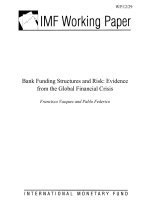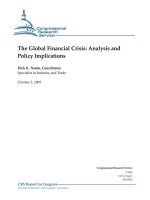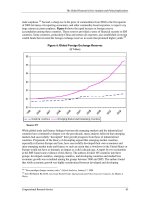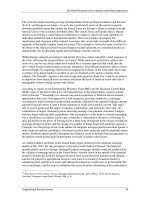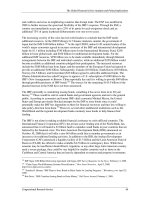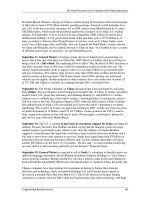berlatsky (ed.) - the global financial crisis (2010)
Bạn đang xem bản rút gọn của tài liệu. Xem và tải ngay bản đầy đủ của tài liệu tại đây (6.41 MB, 262 trang )
THE GLOBAL FINANCIAL CRISIS
THE GLOBAL FINANCIAL CRISIS
e Global Viewpoints series provides students and other readers
with the information they need to explore global connections
and think critically about the worldwide implications of global
issues. Each volume focuses on a controversial topic of worldwide
importance and oers a panoramic view of opinions selected
from a diverse range of international sources, including journals,
magazines, newspapers, nonction books, speeches, government
documents, organization newsletters, and position papers. Each
volume contains an annotated table of contents; a world map, to
help readers locate countries or areas covered in the essays; “for
further discussion” questions; a worldwide list of organizations
to contact; bibliographies of books and periodicals; and a subject
index. By illuminating the complexities and interrelations of the
global community, this excellent resource helps students and other
researchers enhance their global awareness.
GREENHAVEN PRESS
9780737747256_GVP_GLOBAL FINANCIAL CRISIS-HC.indd 1 12/8/09 5:10 PM
The Global
Financial Crisis
Other Books of Related Interest:
At Issue Series
The American Housing Crisis
Introducing Issues with Opposing
Viewpoints Series
Globalization
Opposing Viewpoints Series
Consumerism
Debt
The Global
Financial Crisis
Noah Berlatsky, Book Editor
Christine Nasso, Publisher
Elizabeth Des Chenes, Managing Editor
© 2010 Greenhaven Press, a part of Gale, Cengage Learning
Gale and Greenhaven Press are registered trademarks used herein under license.
For more information, contact:
Greenhaven Press
27500 Drake Rd.
Farmington Hills, MI 48331-3535
Or you can visit our Internet site at gale.cengage.com
ALL RIGHTS RESERVED.
No part of this work covered by the copyright herein may be reproduced, transmitted,
stored, or used in any form or by any means graphic, electronic, or mechanical, including
but not limited to photocopying, recording, scanning, digitizing, taping, Web distribution,
information networks, or information storage and retrieval systems, except as permitted
under Section 107 or 108 of the 1976 United States Copyright Act, without the prior written
permission of the publisher.
For product information and technology assistance, contact us at
Gale Customer Support, 1-800-877-4253
For permission to use material from this text or product, submit all requests online at
www.cengage.com/permissions
Further permissions questions can be emailed to
Articles in Greenhaven Press anthologies are often edited for length to meet page require-
ments. In addition, original titles of these works are changed to clearly present the main
thesis and to explicitly indicate the author’s opinion. Every effort is made to ensure that
Greenhaven Press accurately reflects the original intent of the authors. Every effort has
been made to trace the owners of copyrighted material.
Cover image © Justin Lane/epa/Corbis.
LIBRARY OF CONGRESS CATALOGING-IN-PUBLICATION DATA
The global financial crisis / Noah Berlatsky, book editor.
p. cm. (Global viewpoints)
Includes bibliographical references and index.
ISBN 978-0-7377-4725-6 (hbk.) ISBN 978-0-7377-4726-3 (pbk.)
1. Global financial crisis, 2008-2009 Juvenile literature. 2. Financial crises
Juvenile literature. I. Berlatsky, Noah.
HB3722.G595 2010
330.9 dc22
2009040550
Printed in the United States of America
12345671413121110
Contents
Foreword 13
Introduction 16
Chapter 1: Causes of the
Global Financial Crisis
1. China and Russia Blame U.S. Policies
for the Crisis
22
Jenny Booth
China and Russia accuse the United States and its finan-
cial institutions and regulators of irresponsibly pursuing
profit and ignoring economic danger signs. To meet the
crisis, they called for greater global cooperation.
2. The Greed of Financial Institutions
Caused the Crisis
27
Oskari Juurikkala
Financial institutions wanted large profits, therefore they
hid the risks they were taking from regulators. Better
regulations are important, but businesspeople need to be
more responsible and less greedy.
3. “Boom Thinking” Caused the Crisis 32
Robert J. Shiller
Boom thinking is a kind of social contagion; once a com-
modity starts rising in price, people convince themselves
and then each other that the price will keep going up.
This happened in the United States with home prices,
which rose to unsustainable levels.
4. The Weakness of Banking Regulations
Caused the Crisis
42
Vince Cable
Some British banks have grown too big to fail, and per-
haps too big for regulators to handle. Yet they want free-
dom from regulation and freedom to persue high risk in-
vestments. But the British taxpayer should not be
responsible for financial risks taken outside the nation’s
borders.
5. Low Interest Rates Caused the Crisis 53
Tito Boeri and Luigi Guiso
The housing crisis was fueled by the actions of the chair-
man of the Federal Reserve, Alan Greenspan, who kept
interest rates low. These circumstances encouraged people
to borrow too much to pay for homes they could not af-
ford.
6. Abandoning the Gold Standard
Caused the Crisis
59
Dominic Lawson
If currency is not backed by gold, politicians and bankers
will simply print money, resulting in inflation and a cycle
of boom and bust. The roots of this crisis, therefore, are
in the United States’ decision to abandon the gold stan-
dard in 1971.
7. United States and China Must Join Forces
to Control Crisis
65
Michael Pettis
Imbalances in liquidity and trade in the United States
and China, which started in the 1980s, helped cause the
bubble to burst in 2008. The United States and China
should work together to reduce overspending and over-
production.
Periodical Bibliography 72
Chapter 2: Effects of the Global
Financial Crisis on Wealthier Nations
1. In the United States, the Financial Crisis Creates
Tent Cities and Homelessness
74
Kathy Sanborn
There is a major increase in homelessness and in tent cit-
ies across the United States. This is directly related to the
joblessness and economic distress caused by the financial
crisis.
2. Canada Will Not Suffer a Subprime
Mortgage Crisis
80
Jonathan Kay
Canada had fewer bad mortgages and better lending stan-
dards than the United States. As a result, it did not have
a housing bubble, and it should avoid the mortgage melt-
down that happened in the United States.
3. Australia’s Economy Remains Bound Up
with That of the United States
85
Sean Carmody
Before the crisis, some commentators had argued that
Australia’s economy had decoupled, or separated from
that of the United States and the developed world.
Australia’s economy has not decoupled, however, but has
been battered by the financial crisis.
4. The European Union Is Buckling
Under the Crisis
92
Edward Hugh
Nations throughout Europe, from Ireland to Latvia to
Germany, are suffering severely from the financial crisis.
The European Union must restructure and act more
boldly if it is to remain relevant.
5. In Iceland, an Economic Miracle Ended
in Disaster
101
Andrew Pierce
Iceland was a relatively poor country until the mid-1990s,
when its banking industry took off and its economy ex-
panded enormously. Because of its reliance on banking,
however, the financial crisis hit Iceland particularly hard,
pushing it to the verge of national bankruptcy.
6. The Crisis Fuels Unrest in France, Britain,
China, and Russia
108
Thomas Hüe tlin, Andreas Lorenz, Christian Neef,
Matthias Schepp, and Stefan Simons
The financial crisis has triggered strikes in France and
Britain. In Russia and China, the governments worry that
the crisis may result in challenges to their authority.
7. Israel Will Cut Social Programs, but
Not Military Spending
121
Daniel Rosenberg
Because of the financial crisis, the Israeli government is
putting less money in social programs. Pensions and in-
dustries will also shrink. Arms production, however, is
not being cut.
Periodical Bibliography 127
Chapter 3: Effects of the Global
Financial Crisis on Developing Nations
1. Worldwide, Migrant Workers Are Threatened
by Job Losses and Xenophobia
129
Ron Synovitz
In China, the Persian Gulf states, and Europe, there are
massive job losses among migrant workers. Russia is tak-
ing steps to prevent migrant workers from entering the
country and competing with citizens. Observers worry
that such policies will increase mistrust of foreign work-
ers.
2. In India and China, the Crisis
May Worsen Poverty
135
Jayshree Bajoria
India and China are the most populous nations on Earth,
and their rapid economic growth has been a major factor
in the reduction of worldwide poverty. With the financial
crisis and subsequent reduced growth, poverty, hunger,
and instability may all increase dangerously, especially in
India.
3. China Could Use the Crisis to Become
a Responsible World Power
143
Jing Men
Though the financial crisis has hurt China, it also may
have increased its standing relative to hard-hit areas such
as the United States. China should use this opportunity
to build its economy and work with, rather than against,
the United States to help solve the crisis.
4. The Philippines Is in a Good Position
to Weather the Crisis
150
Antonio A. Esguerra II
Because of a stable banking system and prudent eco-
nomic policies, the Philippines has not been hit as hard
by the crisis as some other nations. The government
plans to increase deposit insurance on bank accounts and
increase domestic spending in order to further mitigate
the effects of the crisis.
5. Latin America Is Struggling to Deal
with the Crisis
157
Woodrow Wilson International Center for Scholars
The financial crisis has curtailed economic growth in
Latin America and threatens to substantially increase
poverty. Governments such as Nicaragua and Ecuador,
which have few reserves, may face social unrest. The re-
gion, however, is much more democratized, and the
threat of coups because of the recession is much less
than it would have been in the past.
6. Islamic Banks Are Insulated from the Crisis 164
Faiza Saleh Ambah
Islamic law prohibits the charging of interest or trading
in debt. As a result, Islamic banks do not use compli-
cated financial instruments or take excessive risks. There-
fore, Islamic banks avoided the bubble and the collapse
that have devastated Western banking.
Periodical Bibliography 170
Chapter 4: Solutions to the
Global Financial Crisis
1. International Investments Complicate
the Financial Crisis and Its Remedy
172
Michael Mandel
Foreign investors put a great deal of money into U.S.
banks that are now failing. Because the investors are for-
eign, it is difficult for the U.S. government to force or
implement a solution alone. Therefore, an international
conference must be held to resolve the crisis.
2. Protectionist Measures Will Worsen
the Crisis
180
Jaime Daremblum
Economic growth is fueled by trade. Therefore, protec-
tionist measures restricting trade will only worsen the
economic crisis. Instead, the United States and the coun-
tries of Latin America in particular and the nations of
the world in general need to commit to non-restrictive
trade policies.
3. In Africa, Ending Neoliberal Economic
Policies Will Solve the Crisis
186
Demba Moussa De mbele
The crisis shows that neoliberal policies that push un-
regulated capitalism have failed. Africa should reject un-
restricted free trade, nationalize key industries, increase
the role of the state in development, and look for local
financing for development rather than relying on the
World Bank and the International Monetary Fund.
4. U.S. Bailouts Are Corporate Welfare
and Will Not Solve the Crisis
201
George Monbiot
People have protested against bank bailouts, but in fact
the American government has always given huge amounts
of money to corporations. Corporations then in turn
spend money on lobbying and campaign contributions
to oppose regulations. This leads to disasters such as the
current financial crisis.
5. Japan’s Experiences Provide Lessons
for Dealing with the Crisis
207
Masaaki Shirakawa
The current financial crisis is very similar to Japan’s “lost
decade,” a period of economic stagnation that ran
throughout the 1990s. Based on that experience, govern-
ments need to act collectively and swiftly with injections
of capital to shore up faith in financial institutions. They
should also expect that recovery may take a long time.
6. The United States Should Follow Sweden’s
Example and Nationalize Its Banks
219
Matthew Richardson and Nouriel Roubini
The U.S. banking system is insolvent. To prevent a com-
plete financial collapse and depression, the government
must nationalize and clean up bad banks, as Sweden did
with its banks in 1992.
7. Sweden’s Experience Does Not Provide
Support for Bank Nationalization
225
Fredrik Erixon
Many argue that Sweden nationalized banks in the early
1990s, thus efficiently solving a financial crisis. In fact,
Sweden was careful not to nationalize banks, which sug-
gests that nationalization is not the solution to the cur-
rent crisis.
Periodical Bibliography 231
For Further Discussion 232
Glossary 234
Organizations to Contact 238
Bibliography of Books 245
Index 249
Foreword
“The problems of all of humanity can
only be solved by all of humanity.”
—Swiss author Friedrich Dürrenmatt
G
lobal interdependence has become an undeniable reality.
Mass media and technology have increased worldwide
access to information and created a society of global citizens.
Understanding and navigating this global community is a
challenge, requiring a high degree of information literacy and
a new level of learning sophistication.
Building on the success of its flagship series, Opposing
View points, Greenhaven Press has created the Global View-
points series to examine a broad range of current, often con-
troversial topics of worldwide importance from a variety of
international perspectives. Providing students and other read-
ers with the information they need to explore global connec-
tions and think critically about worldwide implications, each
Global Viewpoints volume offers a panoramic view of a topic
of widespread significance.
Drugs, famine, immigration—a broad, international treat-
ment is essential to do justice to social, environmental, health,
and political issues such as these. Junior high, high school,
and early college students, as well as general readers, can all
use Global Viewpoints anthologies to discern the complexities
relating to each issue. Readers will be able to examine unique
national perspectives while, at the same time, appreciating the
interconnectedness that global priorities bring to all nations
and cultures.
Material in each volume is selected from a diverse range of
sources, including journals, magazines, newspapers, nonfiction
books, speeches, government documents, pamphlets, organiza-
tion newsletters, and position papers. Global Viewpoints is
13
truly global, with material drawn primarily from international
sources available in English and secondarily from U.S. sources
with extensive international coverage.
Features of each volume in the Global Viewpoints series in-
clude:
• An annotated table of contents that provides a brief
summary of each essay in the volume, including the
name of the country or area covered in the essay.
• An introduction specific to the volume topic.
• A world map to help readers locate the countries or
areas covered in the essays.
• For each viewpoint, an introduction that contains
notes about the author and source of the viewpoint
explains why material from the specific country is being
presented, summarizes the main points of the view-
point, and offers three guided reading questions to aid
in understanding and comprehension.
• For further discussion questions that promote critical
thinking by asking the reader to compare and contrast
aspects of the viewpoints or draw conclusions about
perspectives and arguments.
• A worldwide list of organizations to contact for read-
ers seeking additional information.
• A periodical bibliography for each chapter and a bib-
liography of books on the volume topic to aid in fur-
ther research.
• A comprehensive subject index to offer access to
people, places, events, and subjects cited in the text,
with the countries covered in the viewpoints high-
lighted.
The Global Financial Crisis
14
Global View points is designed for a broad spectrum of
readers who want to learn more about current events, history,
political science, government, international relations, econom-
ics, environmental science, world cultures, and sociology—
students doing research for class assignments or debates, teach-
ers and faculty seeking to supplement course materials, and
others wanting to understand current issues better. By pre-
senting how people in various countries perceive the root
causes, current consequences, and proposed solutions to
worldwide challenges, Global View points volumes offer readers
opportunities to enhance their global awareness and their
knowledge of cultures worldwide.
15
Foreword
Introduction
“The U.S. economy, once the envy of the
world, is now v ie wed across the globe
w ith suspicion. America has become
shackled by an immovable mountain of
debt that endangers its prosperity and
threatens to bring the rest of the world
economy crashing dow n with it.”
—Hamid Varzi,
International Herald Tribune, 2007
F
rom 2008–2009, the world experienced what the Interna-
tional Monetary Fund (IMF) in its 2009 World Economic
Outlook called “by far the deepest global recession since the
Great Depression.” This economic downturn was sparked by a
global financial crisis.
The crisis originated in the United States. During the
2000s, Americans began to invest heavily in houses. As more
and more people purchased houses with borrowed money, the
prices of houses rose and rose. This trend was partially fueled
by low interest rates, which made it cheaper to borrow money.
Thus, Dean Baker, writing in Real-World Economics Review in
2008, noted that “extraordinarily low interest rates accelerated
the run-up in house prices.”
Price inflation of this sort is often referred to as a “bubble.”
William Watson, writing in the Gazette in 2006, said that “A
bubble . . . is a run-up in prices going beyond anything that
reasonable economic calculation can justify.” Watson added
that “when enough people do finally recover their senses . . .
[the] bubble bursts.” This is what happened in the United
States in 2007, and by the end of the year, the bubble had col-
lapsed, and housing prices had dropped more than 15 per-
cent.
16
During the bubble, banks had often lent money to people
who were bad credit risks; these loans are known as subprime
mortgages. The banks figured that as long as housing prices
went up, they would always be able to recover their money,
because even if a creditor defaulted, the house itself could al-
ways be sold for a profit. Based on this theory, banks repack-
aged and sold these mortgages as investments, or mortgage-
based securities. Thus, an investor could buy a bunch of
mortgages (or a small piece of a bunch of mortgages) which
were guaranteed to pay back a certain return.
The banks were so sure that these mortgage-based securi-
ties would always pay that they even sold insurance on the in-
vestments. These insurance contracts were called credit default
swaps. A credit default swap (CDS) means an investor in
mortgage-based securities would pay a certain amount of
money to the bank on a regular basis as long as the securities
made money. If the securities ever stopped making money,
though, the bank would have to pay the investor a large sum.
CDSs were very popular because they made investors feel
safer, and banks were certain they would never have to pay on
them; investments would never default because housing prices
would go up forever, or so they believed. As a result, as Janet
Morrissey reported in TIME in 2009, “The CDS market ex-
ploded over the past decade to more than $45 trillion in
mid-2007 This is roughly twice the size of the U.S. stock
market.”
When the bubble burst and housing prices did start to go
down, banks found themselves in a precarious position. Much
of the banks’ money was invested in mortgages that were now
shown to be bad debts. To make matters worse, the banks had
in many cases promised to pay other investors through credit
default swaps if these loans went bad. The resulting strain
caused a series of catastrophic failures of large banks in the
United States. Bear Stearns, a large investment bank, first
noted publicly that it was having trouble because of subprime
17
Introduction
loans in July 2007. On September 7, 2008, Fannie Mae (Federal
National Mortgage Association) and Freddie Mac (Federal
Home Loan Mortgage Corporation), the two largest mortgage
lenders in the United States, had to be bailed out by the U.S.
government. On September 15, 2008, Lehman Brothers, an-
other large bank, declared bankruptcy. In the following weeks,
Washington Mutual also collapsed. The U.S. government also
stepped in to save the nation’s largest insurance company,
AIG. The rescue package was $85 billion.
The banking crisis was not confined to the United States.
In the first place, other nations had their own housing bubbles.
Even more important, banks and investors around the world
had placed money in U.S. mortgages. As Jim Haughey wrote
on the blog Market Insights, “Foreign investors were net buy-
ers of about $20 billion a month of agency bonds throughout
the 2004–05 housing boom and through mid-2008.” Thus,
foreign banks faced many of the same problems U.S. banks
did when the U.S. housing bubble burst. As a result, in Octo-
ber 2007, the German government was forced to spend $50
billion to prop up the bank Hypo Real Estate. Around the
same time, Iceland nationalized, or imposed government con-
trol of, the country’s second largest bank. In February 2008,
the British government also had to nationalize one of its ma-
jor banks. The problem was not solely confined to Europe. In-
vestors in Asia, especially in China, also held many U.S. assets.
The bank crisis has had a major impact on the world
economy. Stock markets worldwide plunged; the U.S. Dow
Jones average dropped to its lowest level since 1997. Britain’s
stock market was down by more than 5 percent at one point,
while Japan’s stock market fell by almost 4 percent.
Another impact of the financial storm has been a liquidity
crisis. Liquidity is the ability to raise cash quickly. Many busi-
nesses rely on short-term borrowing to meet payroll or other
obligations. But, as Chris Arnold noted in an October 2008
story for National Public Radio (NPR), “banks are already
The Global Financial Crisis
18
short of cash because of losses in the housing bust, so they’re
a lot less willing to lend money to everybody else.” Without li-
quidity, many businesses can’t function.
As businesses fail, unemployment rises and the economy
spirals into a recession. This has had a devastating effect
worldwide. The International Monetary Fund and the World
Bank released a joint statement in April 2009 calling the reces-
sion “a human and development calamity” which “has already
driven more than 50 million people into extreme poverty.”
The International Labour Organization predicted that 20 mil-
lion jobs would be lost by the end of 2009. Increases in pov-
erty and unemployment have also resulted in angry protests
from Iceland to France to China. Jack Ewing, writing in Busi-
ness Week in March 2009, noted that “global political instabil-
ity is rising fast.” Governments have responded in various
ways to the crisis. As noted, some have bailed out or national-
ized failing banks. Many nations have also put together stimu-
lus packages to jump start the economy and create jobs. China
announced a $586 billion stimulus plan in November 2008.
The United States passed a $780 billion stimulus in February
2009; in the same month Germany passed a $63 billion pack-
age and Australia a $27 billion one.
In March 2009, Vikas Bajaj reported in the New York Times
that the economy was turning around, or as he put it, “there
was a sense among some economists and Wall Street analysts
that if the bottom was not touched, perhaps the freefall was at
least slowing.” Stock markets seemed to be ticking upwards,
and some banks were reporting profits again. Few are willing
to predict whether the recovery will last or what the long term
effects of the economic crisis will be. Global Viewpoints: The
Global Financial Crisis addresses the causes of the crisis, the
effects on wealthy and developing nations, and recommenda-
tions for the future.
19
Introduction
North
America
Australia
Asia
South
America
Africa
Europe
Antarctica
The Global Financial Crisis
20
CHAPTER
1
Causes of the Global
Financial Crisis
21
China and Russia Blame
U.S. Policies for the Crisis
Jenny Booth
Jenny Booth has written articles for the Times of London and
the Sunday Times. In this viewpoint, she reports that the leaders
of China and Russia accused America of creating the economic
cr isis through greedy pursuit of profit, low saving s rates, high
consumption, and poor regulations. Booth asserts that China
and Russia have suffered in the financial c risis, and there has
been a lack of cooperation among these two powers and the
United States to get the interdependent economy back on track.
As you read, consider the following questions:
1. Who are the premiers of China and Russia?
2. According to Vladimir Putin, how long did it take in-
vestment banks to post losses exceeding the profits that
they made in the last 25 years?
3. According to the International Monetary Fund, what is
China’s predicted growth rate for 2009?
T
he premiers of China and Russia accused America of
sparking the economic crisis as the Davos [Switzerland]
political and business summit made a gloomy start.
Wen Jiabao and Vladimir Putin [the premiers of China
and Russia, respectively] both blamed “capitalist excesses” for
Jenny Booth, “China and Russia Blame US for Financial Crisis,” Times Online, January
29, 2009. Copyright © 2009 Times Newspapers Ltd. Reproduced by permission.
1
Viewpoint
22
the global downturn, as one followed the other to the podium
at the opening of the World Economic Forum last night [Janu-
ary 2009].
American Policies Were Reckless
The Chinese premier began with a speech asserting that the
worst recession since the Great Depression had been caused
by blind pursuit of profit.
In a thinly veiled attack on America, Mr. Wen blamed “in-
appropriate macroeconomic policies of some economies” and
“prolonged low savings and high consumption”.
The Chinese premier began with a speech asserting that
the worst recession since the Great Depression had been
caused by blind pursuit of profit.
He blasted the “excessive expansion of financial institu-
tions in blind pursuit of profit and the lack of self-discipline
among financial institutions and ratings agencies”, while the
“failure” of regulators had allowed the spread of toxic deriva-
tives.
23
Causes of the Global Financial Crisis
The Chinese leader called for faster reform of interna-
tional financial institutions and for a “new world order” for
the economy.
Mr. Putin, the Russian premier, following him to the po-
dium, accused bankers, regulators and politicians of turning a
blind eye to the “perfect storm” that was building before their
eyes.
“This pyramid of expectations would have collapsed
sooner or later. In fact it is happening right before our eyes,”
said Mr. Putin.
“Although the crisis was simply hanging in the air, the ma-
jority strove to get their share of the pie, be it one dollar or
one billion, and did not want to notice the rising wave.”
Mr. Putin said that he would not criticise the United States,
but then added: “I just want to remind you that just a year
ago, American delegates speaking from this rostrum empha-
sised the US economy’s fundamental stability and its cloudless
prospects.”
Condoleezza Rice, when US secretary of state, gave a
speech in Davos last year [2008] saying the US economy was
safe.
Mr. Putin went on: “Today investment banks, the pride of
Wall Street, have virtually ceased to exist. In just 12 months
they have posted losses exceeding the profits they made in the
last 25 years. This example alone reflects the real situation
better than any criticism.
“The existing financial system has failed. Sub-standard
regulation has contributed to the crisis, failing to duly heed
tremendous risks.”
Cooperation Is Necessary
Mr. Wen said that the crisis had posed “severe challenges” for
China, which has pursued a mirror image policy of investing
heavily in the United States and buying up US debt, just as
America was plunging deeper and deeper into the red.
The Global Financial Crisis
24
The effects of the downturn have hit Chinese jobs and
overseas markets, causing some social unrest. Four million mi-
grant Chinese workers have so far been thrown out of work.
Mr. Wen said that China now needed 8 percent growth in
2009 to maintain social stability, while the International Mon-
etary Fund predicted 6.7 percent for this year.
Both Mr. Wen and Mr. Putin called for greater coopera-
tion in international affairs from new US President Barack
Obama—conspicuous by his absence from Davos, as he battles
to get his $825 bn [billion] fiscal stimulus package through
Congress.
The prospects for cooperation between the US and China
have seemed to recede in recent days, after the new US Trea-
sury Secretary Timothy Geithner last week revealed that Mr.
Russia Is Drowning in Bad Debt
Russian banks’ bad loans will quadruple to $70 billion this
year [2009], deepening the country’s worst financial crisis
since the government’s 1998 debt default, a Bloomberg sur-
vey shows.
Non-performing loans will increase to 12.8 percent of
the 18.4 trillion rubles ($549 billion) owed by Russian com-
panies and individuals by the end of this year
The World Bank said last week that a “silent tsunami”
of bad debt threatens to stall a recovery in Russia, the
world’s largest energy-exporting economy. The government
may need to provide as much as $50 billion for bank bail-
outs.
Emma O’Brien and William Mauldin,
“Russia Bad Loans May Reach $70 Billion, Deepen Crisis,”
Bloomberg.com, April 9, 2009. www.bloomberg.com.
25
Causes of the Global Financial Crisis

